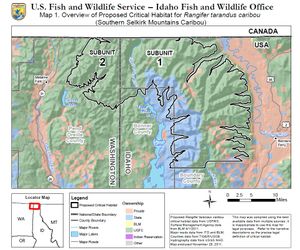Feds back off big time on caribou habitat protections
ENDANGERED SPECIES -- The U.S. Fish and Wildlife Service has downsized its recommendation by more than 10 times for woodland caribou critical habitat in the Sellkirk Mountains. In a country accustomed to supersizing everything, this is a notable example of supershrink.
The map above shows the orginal proposal.
The final critical habitat designation is posted here.
See documents involved in this final designation here.
The announcement came Tuesday, just days after Bonner County filed a lawsuit challenging legal protections for caribou, but FWS officials say there was no connection.
Idaho's Congressional delegation lauded the federal agency's new light-size critical habitat designation.
The designation will be enacted on Jan. 30.
INFO: Go to the Federal eRulemaking Portal: In the Keyword box, enter Docket No. [FWS–R1-ES-2011-0096]. In the Search panel on the left side of the screen, under the Document Type heading, click on the Proposed Rules link to locate this document. You may submit a comment by clicking on “Send a Comment or Submission.”
Meantime, the Idaho Conservation League offers points to ponder about this dubious decision and the precarious position it presents for this endangered species.
Click "continue reading: to see the points:
How unique are woodland caribou?
It is important to note that “woodland” or “mountain” caribou are a distinct subspecies that differ from the large, iconic caribou herds that inhabit the tundra. The status of the woodland caribou is summarized on page 10 of the latest Fish and Wildlife Service Status Review (2008). The total population of woodland caribou throughout its geographic range is thought to be less than 2,000 individuals:
Their range has declined by approximately 43% in BC, and some estimates indicate a 60% decline when considering the combined BC and US historic distribution (MCTAC 2002). Overall numbers decreased from approximately 2,300 animals in the mid-1990s to approximately 1,939 animals in 2008 (Seip 2008a). Currently, the entire global population of mountain caribou occurs within BC, Idaho, and Washington, where they are considered to be at risk of extirpation.
(Emphasis added).
How many caribou are there in the South Selkirk herd?
The Final Rule provides a brief summary of the status of the South Selkirk Mountains herd (Pages 16 and 17):
The number of woodland caribou detected in the United States has continued to dwindle, and annual census surveys continue to find the bulk of the remaining population occupying habitats in British Columbia. The most recent census information demonstrates a decline from 46 caribou in 2009 to 27 animals in 2012, although the cause of this decline has not been described (Degroot and Wakkinen 2012, p.2). The 2011 survey documented zero caribou in the United States, and the 2012 survey documented 4 caribou on Little Snowy Top Mountain, Idaho.
(Emphasis added).
Does the habitat designation meet the needs of caribou?
The final rule designates the habitat that was occupied when caribou were listed as endangered in 1983. Unfortunately, this represents that habitat used by an imperiled herd rather than a recovered herd. More habitat must be protected to have a growing herd and achieve recovery.
What else should be done to recover woodland caribou?
The habitat designation alone will not lead to the recovery of caribou. The most recent recovery plan for woodland caribou dates back to 1994. Since the recovery plan is outdated, the Fish and Wildlife Service should develop an updated recovery plan.
Sources available upon request.

